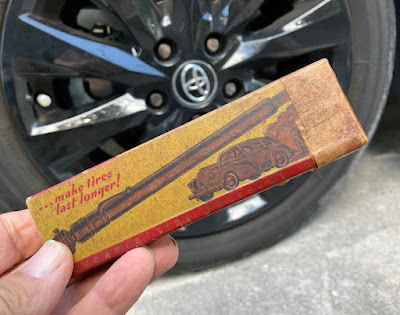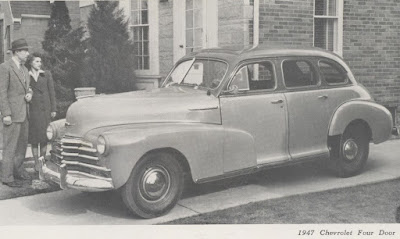 |
| What do you do when the tire pressure warning light comes on? |
No one wants to see that glowing dashboard light warning that a tire is low on pressure. Maybe it's just a cool morning and the tire is just a bit low on pressure because it is cold. Or, maybe it's flat.
In the old days, a driver suspecting a tire low on air would have to pull over, get out, and look at his tires. He would be hoping not to see a shrinking tire, hissing air out of a hole.
In modern times, the driver stays in his seat and presses a dashboard screen that tells him the pressure in his tires and even, if he is lucky, which tire is low on air.
Oh, for those good old modern times.
In even more modern times, I find that there is no such specific information on the dashboard. Instead, I am forced to get out my phone and use an app to find out about tire pressure.
Just the other day, with the dashboard warning light suddenly lit, I found that the app judged my left front tire to be low on air: only 28 pounds of pressure. I got my tire pump out of the trunk, and added 60 strokes of air to the tire. I rechecked the ap.
Still low on air, it claimed: only 28 pounds. What did the tire do with those 60 strokes of the tire pump?
I got out the tire pump, and added 75 more strokes. The ap would not admit that this added any air. It still found only 28 pounds of air, and the dashboard warning light remained on.
Once home I ducked into the garage and fished out my Schrader tire pressure gauge, a pencil shaped device. Applied to a tire valve, it shoots out a wand marked to reveal tire pressure.
 |
| Battered original box indicates age of this tool. |
It found 46 pounds of tire pressure in the left front tire. Fooled by the ap, I had overfilled the tire.
My Schrader tire pressure gauge is still shiny despite its age. Judging by the box it came in, the device dates from not long after World War II. A 1940s car, with bulging fenders, graces the box cover.
 |
| The box cover shows a car of the 1940s. |
I'm was going to say the illustration is a 1947 Chevrolet four-door.
 |
| 1947 Chevrolet four door may have inspired the box illustration. |
But an even stronger contender for the box cover illustration might be the Nash Ambassador of the 1940s. The only discrepancy I see is that the fender line of the car on the box seems to be carried into the front door, as on the Chevrolet. But it's hard to tell, and the grille of the Nash (below) is a much better match.
Schrader's headquarters were only in New York until 1966, so my gauge predates that year. It's probably older than 1963, because that is the year Zip Codes replaced the "17" district code in Brooklyn.
I know I didn't purchase this gauge. It would have been given to me by my father, probably, or perhaps I found it in 1996, in a drawer at the 1955 Florida house we bought from its first owner. The original box is much taped to hold it together; that would be very like the meticulous gentleman who previously owned our house.
It's old tech. The pencil gauge tube contains a piston, a spring, and the labelled wand that emerges to tell you the pressure reading. When connected to the air in the tire the piston moves accordingly until the spring brings it to a stop. On the other side of the piston, but not connected to it, is the wand.
 |
| Wand emerges from tool to show tire pressure. |
The piston forces the wand the appropriate distance from the base of the pencil but, since it is not connected to the spring-loaded piston, the wand does not retract when the gauge is removed from the tire. Since the wand remains outside the tube until you push it back in, you have all the time you want to contemplate the reading, and your fate.
Knowledgeable readers will explain that the tire pressure app my car uses simply takes time to update its readings. So far, it has not updated in 24 hours, and continues to insist on its incorrect reading.
There is debate about whether the piston/spring/wand tool is more or less accurate. My guess is that mine, at least, is close enough. And it sure gives immediate results.



























No comments:
Post a Comment